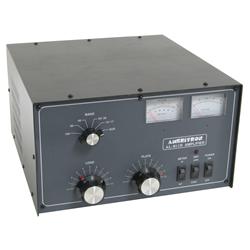When it comes to contesting, are you ready to jump from “Little Pistol” to “Big Gun”? A “Big Gun” refers to a station equipped with all the bells and whistles, including amplifiers.
Just about all the big contest stations use amplifiers. A few examples include K3LR with custom single band, 8877 amplifiers; W3LPL’s custom-made amps with reliable 3-500Z tubes; and K9CT’s Alpha 87A amps. So what’s right for your station?
Basics
Before you drag out your catalogs or start surfing the web for amplifiers, be sure you’ve taken care of the basics first.
Antennas: Do you have antennas and feedline that will handle high power/full legal power? Do they already function well on both transmit and receive? Does your station have proper grounds and RFI suppression? Are the SWR readings reasonable, or do you have a tuner (or plan to get one) to adjust any mismatches?
AC Power: Does your shack have a 240V outlet—most higher power amplifiers require them. Lower power amps, usually less than a kilowatt, can often operate on a standard 120V, 15A circuit.
Tube vs. Solid State
There are lots of amplifier choices, both new and used. Your personal choices will likely be based on cost, operating style, and other factors.
Solid-state amps are great for quickly changing bands. They require no warm-up time so you can use them immediately. However, they are pricey compared to a tube amp with the same rated power output. They are also not very forgiving when it comes to high SWR readings. In most cases, they may go into fault mode on an SWR greater than 2:1 by reducing output power or even shutting the amp down. This protects the finals from damage.
Some have built-in auto tuning and all can be used with an external tuner to properly match your antennas. They’re generally lighter weight, more power-efficient (less heat generated per watt of output), and there are no tubes to burn out or replace. But solid-state amps are usually more complex to service.
Tube amps are becoming long in the tooth, but they’re cheaper per watt and more forgiving when it comes to reflected power. If your antennas exhibit an SWR of 3:1 or less, you may not require a tuner at all. However, the tuning process becomes a bit more time consuming if you regularly change frequencies or bands. This could be a factor if you use the “hunt and pounce” method during contesting. Also, warm-up time can take as much as 2-3 minutes before you actually get on the air.
When it comes time for repair, the tube is the most likely culprit. You remove it and plug a new one in—no problem for amps that are currently being manufactured. However, tube manufacturers have been disappearing over the years, making it more challenging—and expensive—to find replacements for older tube amplifiers.
With solid-state amps becoming more popular, there’s an active used market for tube amps. This could be a great opportunity to pick up an older tube amp at a bargain price.
So the choice of tube or solid state basically comes down to tube (lower cost) or solid-state (agility). Whichever you choose, you might want to start small. Ease into contesting with a 500W amp and later move to 1,000 or 1,500 if you feel the extra power is justified. Here’s a short list of amps that may meet your contest needs.
Solid State Amplifiers
Ameritron’s ALS-600S is a 600W, solid-state linear amplifier that has been around for nearly two decades. This amplifier provides continuous frequency coverage with no tuning adjustments. An Ameritron modification kit available from DX Engineering adds 10 and 12 meter band coverage to the ALS-600S’s 160 through 15 meter capabilities.
The Palstar LA-1K is a 1,000W amplifier featuring RF sensing for automatic band changing, so a transceiver band interface cable is not needed. It’s solidly built and runs from a simple menu screen. The LA-1K will work with a wide variety of tuners and transceivers and operates on 120V at 15A or 240V at 10A.
Tube Amplifiers
If you go the tube route, an Ameritron 811H HF Power Amplifier is a bargain, providing the most watts for the buck (800W PEP output). Replacement tubes are inexpensive and readily available. This amp covers all HF bands, 160 through 15 meters (10 and 12 meters are available with minor modification), and operates on 120V.

Ameritron’s AL-80B HF Power Amplifier is a rock-solid choice for a true balance between cost, performance and reliability. It can run using a 120V or 240V power feed and boasts coverage from 160 through 15 meters (10 and 12 meters are available with minor modification). It features a rugged 3-500Z tube that has been around for well over half a century and is easily obtainable. ACOM’s 1500 HF + 6 Meter Linear Amplifier provides legal limit 1,500W output from a 4CX1000A final on all amateur bands from 160 through 6 meters. The TRI tuning aid helps you quickly and precisely match the antenna impedance to the optimum tube load impedance. It is recommended to use 240V operation, though it will operate at 120V.

